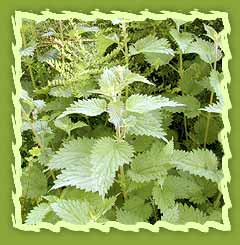
A perennial growing to 1.5m, with lance-shaped leaves and green flowers with yellow stamens in axillary cymes.
Chemical Constituents
Flavonoids, amines, Glucoquinone, Minerals, Plant sterols, Phenols. Other vitamin ingredients are Vitamins C and E, along with minerals, and rich in chlorophyll when eating the cooked nettle shoots.
Cosmetic Uses
In reality the herb is very rich in Vitamin A and C. It also provides an excellent source of calcium and iron. Nettles Leaf Powder A valuable herb with many uses, especially useful in hair care products. Can be used as is in soap, or to make a tincture or extract.
Has a long history of use in traditional medicine. Its flesh is rich in minerals and plant hormones and it stimulates hair growth and softens the hair. It is used as a hair rinse (especially for light hair): wash and dry nettle roots; soak 2 handfuls of roots in 2 quarts of cold water overnight; next day bring mix to a boil and then simmer for 10 to 15 minutes; strain roots; use remaining liquid as a hair rinse. Will yield greenish yellow from the above-ground plant with an alum mordant. Make a weak nettle tea as a face wash to firm up skin and remove excess oils. A nettle vinegar made with 1 ounce of fresh nettle in 6 ounces cider vinegar is an excellent astringent. A very strong nettle tea combed through the fair will reduce grey over time and will stimulate the scalp.
This herb is a popular product in shampoos and facials. It has been well tested and shown to have anti-inflammatory properties. Because it is a vasodilator it has been used medicinally to excite the skin locally. It is also used for stimulating hair growth, treating dandruff and used to treat dark circles around the eye.
The stinging reaction caused by the plant hairs is said to contain many active ingredients, such as formic acid, like what ant's inject when they bite your skin and make you sting and burn, not to mention, itch. Other ingredients include: histamine, serotonin, acetylcholine, hydroxytryptamine and other irritants. So, many of these ingredients are neurotransmitters and affect nerve cells, so this is probably why it gives such an irritant effect, and why it may be better used for alopecia areata.
Medicinal Uses
Diuretic, Tonic, Astringent, Prevents hemorrhaging, anti-allergenic, Increases breast- milk, production, reduces prostate enlargement. Blood purifier, and diuretic.
Primary use has been for allergies (usually taken in capsule form). Used for urinary problems and rheumatic problems. Used for anemia, arthritis, food or pollen allergies, head and chest colds, relief of asthma and bronchial cough, hay fever, and prostratitis. The tea with honey and lemon is used as a stimulant.Increases flow of milk in nursing mothers. Makes an astringent gargle for sore throats and mouthwash for bleeding gums.
Animal Uses
Dried nettles are highly recommended as a supplement for some animals. Drying causes the needles to become completely ineffective and then the plant can be eaten with no unpleasant sensations. Rabbits love dried nettles in the winter time and I always gathered lots for them. It acts as a tonic for them and they would leap very excitedly around when they smelled me handling them. Newly hatched poultry grow more quickly if dried nettles are powdered into their food for the first 2-3 weeks of their lives.
No comments:
Post a Comment